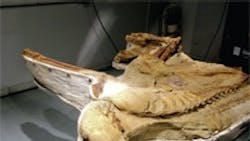Historic Handling: Transport Packaging, Material Handling Aid Science
“It was the chance of a lifetime,” says Bill Armstrong, technical development manager for Sealed Air Corp. Armstrong led a team of transport packaging professionals to design, test and implement a packaging solution to transport a two-ton, irreplaceable artifact across the country.
Exactly whose lifetime, Armstrong’s or the Brachylophosaurus Canadensis (duck-billed dinosaur), isn’t clear. Leonardo (See how he got this moniker by checking out the box on page 22.) was cited by the Guinness Book of Records as the most complete, reticulated dinosaur fossil ever unearthed.
The “mummified” dinosaur was discovered by the Judith River Dinosaur Institute (JRDI) in Malta, Mont., July 27, 2000 after spending the last 77 million years or so underground. A crew of more than 25 volunteers, including paleont-
ologists and geologists, successfully extracted the big guy from his cement-like tomb for research. The dinosaur had been remarkably preserved, so paleontologists suspected there would be fossilized organs within the torso of the creature.
Packaging Challenge
To know for certain the internal condition of the animal, the scientists needed to move the fragile artifact to NASA’s Johnson Space Center in Houston where it could be scanned using state-of-the-art equipment. The entire process was documented by the Discovery Channel.
Early in 2007, Art Anderson, a member of the science team working on the project, began searching for a transport packaging solution that would safely move the fossil more than 2,000 miles. He was referred to Armstrong, who specializes in creating custom-packaging solutions for the toughest challenges.
During the past year, Armstrong led a team of packaging experts drawn from Sealed Air, International Safe Transit Association (ISTA), Lansmont Corp. and the U.S. Navy to develop and test the best packaging solution for the situation.
After months of planning and several trips to the dinosaur dig, the Sealed Air team finally traveled to Montana in February 2008 to execute the design they had created over the latter half of 2007. The solution was worked out in Sealed Air’s Danbury, Conn., packaging dynamics lab. During three days on-site, the team assembled the base on which the fossil would ride. It built the reinforced crate to hold and protect the fossil and completed the shock isolation system on which the crate would travel.
There were plenty of sweaty palms in the room as Leonardo was lifted off his supports in the JRDI field station and mounted on his new base for transport. The fossil was shrink wrapped with Sealed Air’s CorTuff film to stabilize the fragile surface. Typically used for industrial applications, such as carpeting and construction materials, CorTuff is a high-abuse shrink film, said to be the strongest shrink film available.
After the film was successfully wrapped around the fossil, the unit was blocked and braced on the base using Sealed Air’s Instapak foam—a fast, easy and versatile process for on-line, on-site production of protective polyurethane foam packaging, commonly found around much smaller, yet fragile, items. Instapak foam has unique cushioning properties that protect products during shipping, warehousing and handling.
When activated, Instapak foam expands up to 200 times its volume. Its liquid volume expands in seconds to form custom-fit, protective cushions.
The team then carefully moved the assembled crate to the trailer and mounted it atop the shock isolation system layered with three inches of Sealed Air’s Stratocell H polyethylene foam. The Stratocell H foam was strategically arrayed to support and protect the 4,000-pound fossil. Stratocell H polyethylene high-density foam provides cushioning protection against repeated shock and transport vibrations.
Nail-biting Time
Armstrong and the Sealed Air team, along with several of the project scientists, eagerly awaited the tractor trailer’s arrival in Houston after its 2,000-mile journey. The crate was carefully removed from the truck into a NASA hangar, where it was finally opened.
“Not a grain of sand was out of place,” said one of the paleontologists on the science team. “Sealed Air exceeded our packaging expectations.”
“Obviously, an opportunity like this is rare,” says Armstrong. “Working with a team of experts to transport a 77-million-year-old, irreplaceable item was beyond my wildest dreams.”
Shortly after unpacking the crate, the science team, with support from NASA, started scanning the fossil to determine if the fossilized organs were indeed intact. The scanning took place under strict security. The findings were revealed when “Secrets of the Dinosaur Mummy,” the documentary filmed throughout the process, debuted worldwide on Sept. 14 on Discovery HD.
“We don’t know yet what the scientists found inside the fossil, but we know nothing was displaced during transit,” says Armstrong. “We’ll have to watch the documentary to find out.”
Shortly after our interview with Armstrong, Dr. Robert Bakker, curator of paleontology, Houston Museum of Natural Science, revealed that Leonardo has shown scientists, for the first time, the bio energetics (digestive) process in dinosaurs.
“Looking at the dark mass within the stomach area of the animal,” says Bakker, “we can see conifer needles and cones. For the first time, we can follow this process back through the large and small
| Dino Facts • The fossil was named Leonardo because there was graffiti on a boulder near where it was discovered that read “Leonard Webb and Geneva Jordan, 1917.” • Paleontologists believe the dinosaur was about four years old when it died. • Leonardo is “mummified,” with more than 90% of the dinosaur covered with fossilized soft tissue. • Leonardo is one of only four existing brachylophosaurus specimens uncovered to date. |
intestines. That’s cool!”
